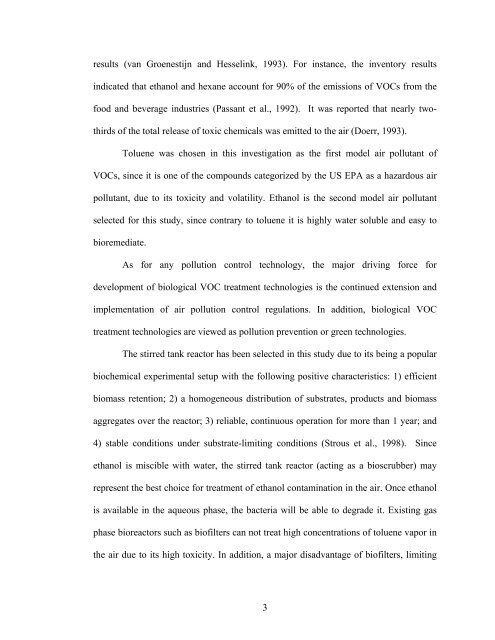Experimental Study of Biodegradation of Ethanol and Toluene Vapors
Experimental Study of Biodegradation of Ethanol and Toluene Vapors
Experimental Study of Biodegradation of Ethanol and Toluene Vapors
You also want an ePaper? Increase the reach of your titles
YUMPU automatically turns print PDFs into web optimized ePapers that Google loves.
esults (van Groenestijn <strong>and</strong> Hesselink, 1993). For instance, the inventory results<br />
indicated that ethanol <strong>and</strong> hexane account for 90% <strong>of</strong> the emissions <strong>of</strong> VOCs from the<br />
food <strong>and</strong> beverage industries (Passant et al., 1992). It was reported that nearly twothirds<br />
<strong>of</strong> the total release <strong>of</strong> toxic chemicals was emitted to the air (Doerr, 1993).<br />
<strong>Toluene</strong> was chosen in this investigation as the first model air pollutant <strong>of</strong><br />
VOCs, since it is one <strong>of</strong> the compounds categorized by the US EPA as a hazardous air<br />
pollutant, due to its toxicity <strong>and</strong> volatility. <strong>Ethanol</strong> is the second model air pollutant<br />
selected for this study, since contrary to toluene it is highly water soluble <strong>and</strong> easy to<br />
bioremediate.<br />
As for any pollution control technology, the major driving force for<br />
development <strong>of</strong> biological VOC treatment technologies is the continued extension <strong>and</strong><br />
implementation <strong>of</strong> air pollution control regulations. In addition, biological VOC<br />
treatment technologies are viewed as pollution prevention or green technologies.<br />
The stirred tank reactor has been selected in this study due to its being a popular<br />
biochemical experimental setup with the following positive characteristics: 1) efficient<br />
biomass retention; 2) a homogeneous distribution <strong>of</strong> substrates, products <strong>and</strong> biomass<br />
aggregates over the reactor; 3) reliable, continuous operation for more than 1 year; <strong>and</strong><br />
4) stable conditions under substrate-limiting conditions (Strous et al., 1998). Since<br />
ethanol is miscible with water, the stirred tank reactor (acting as a bioscrubber) may<br />
represent the best choice for treatment <strong>of</strong> ethanol contamination in the air. Once ethanol<br />
is available in the aqueous phase, the bacteria will be able to degrade it. Existing gas<br />
phase bioreactors such as bi<strong>of</strong>ilters can not treat high concentrations <strong>of</strong> toluene vapor in<br />
the air due to its high toxicity. In addition, a major disadvantage <strong>of</strong> bi<strong>of</strong>ilters, limiting<br />
3















